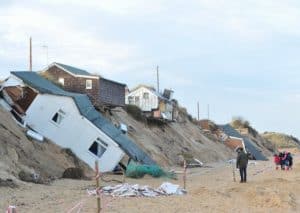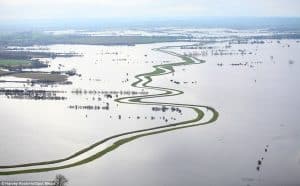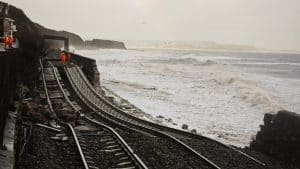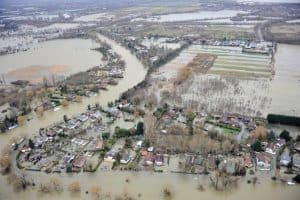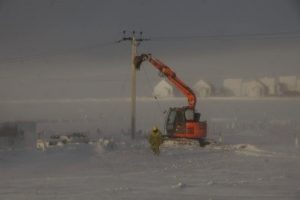The UK can experience extreme weather. Examples include:
- Flooding
- Storms
- High winds
- Droughts
- Blizzards
CASE STUDY
The winter of 2013-14 was one of the wettest and windiest on record.
Causes
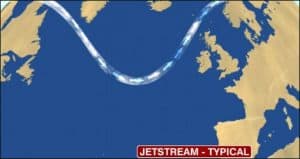 The jet stream is a 200mph wind in the upper atmosphere. The jet stream steers the course of depressions across the Atlantic. Depressions are areas of low pressure, with rising air, strong winds and rain. Typically the jet stream is north of the UK. This means most storms pass to the north of Scotland.
The jet stream is a 200mph wind in the upper atmosphere. The jet stream steers the course of depressions across the Atlantic. Depressions are areas of low pressure, with rising air, strong winds and rain. Typically the jet stream is north of the UK. This means most storms pass to the north of Scotland.
 In the winter of 2013-14 the jet stream was much further south than normal. This steered the course of depressions across the UK for several months. This caused the weather to be much wetter and windier than a typical winter.
In the winter of 2013-14 the jet stream was much further south than normal. This steered the course of depressions across the UK for several months. This caused the weather to be much wetter and windier than a typical winter.
Effects
Hemsby, Norfolk
A storm surge occurred on 5th Dec 2013. Low air pressure and strong winds raised sea levels 6m along the North Sea coast. This meant that there was rapid erosion of the cliffs. Many homes were lost like these 5 bungalows in Hemsby.
Somerset Levels
Winter storms brought heavy rain to the UK. December 2013 and January 2014 were some of the wettest months in Southern England on record. The River Parrett burst its banks and 17 000 acres of Somerset were flooded along with 600 homes in many villages.
Aberystwyth, Wales
On the 3rd January 2014 Storm Christine struck the UK. The 70mph winds and large waves battered the seafront in Aberystwyth causing £1.5 million of damage.
Dawlish in Devon
On 4th February 2014 a large storm struck the south coast of the UK. It washed away 100m of train track in Dawlish. This meant that no trains could carry passengers to Cornwall for months. It cost £35 million to repair.
Chertsey, Surrey
The winter storms brought heavy rain to Southern England. The River Thames flooded 900 homes along its banks like those here in Chertsey. It was the worst flooding on the Thames for 30 years.
Scotland
On 5th December 2013 Storm Xavier hit Scotland. The 142mph winds brought down power lines and 100 000 people were without electricity. Heavy snow falls made repairs difficult, like here in the Shetland Islands.
Responses
You can prepare the UK to cope with extreme weather. Warnings can be given to lorry drivers when high winds are expected. Bridges may even be closed in extreme weather. Emergency teams and plans can be prepared to assist people in floods, for example, flood warnings, evacuation plans and emergency centres. Sea defences can be built to deal to coastal flooding in a storm surge.
In the UK specifically…
- £20 million has ben spent dredging the River Parrett in Somerset and installing pumps. This will increase the capacity of the river and mean that there should less flooding in the future.
- £35 million spent repairing railway in Dawlish, Devon, damaged during winter storms. They have built a reinforced sea wall to prevent erosion damaging the track in the future.
- A bee hive barrier has been built at Hensby at the foor to the cliffs. This defends the soft cliffs from from further erosion and prevent any more lost homes.
Evidence for extreme weather
- The Met Office reported the storms of 2013-14 were responsible for the wettest December to January period since 1876.
- The Met Office reported that December 2013 was the windiest month since January 1993.
- The Environment Agency described the storm surge of 2013 as the most serious in 60 years. Sea water heights exceeded those of the 1953 and 1978 North Sea storm surges.
- The winter storms brought very low air pressure and strong winds – 927millibars of air pressure is the lowest recorded in the UK since 1884.
- Southern England had double the average amount of rainfall in January 2014.
.
